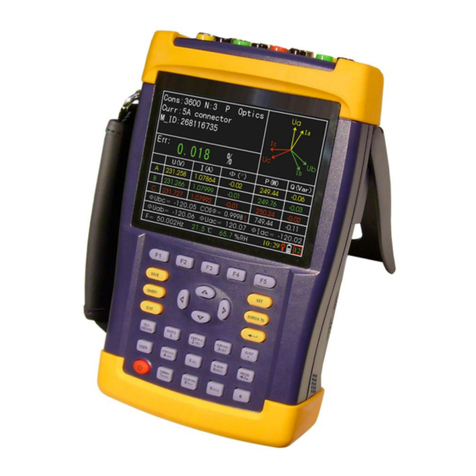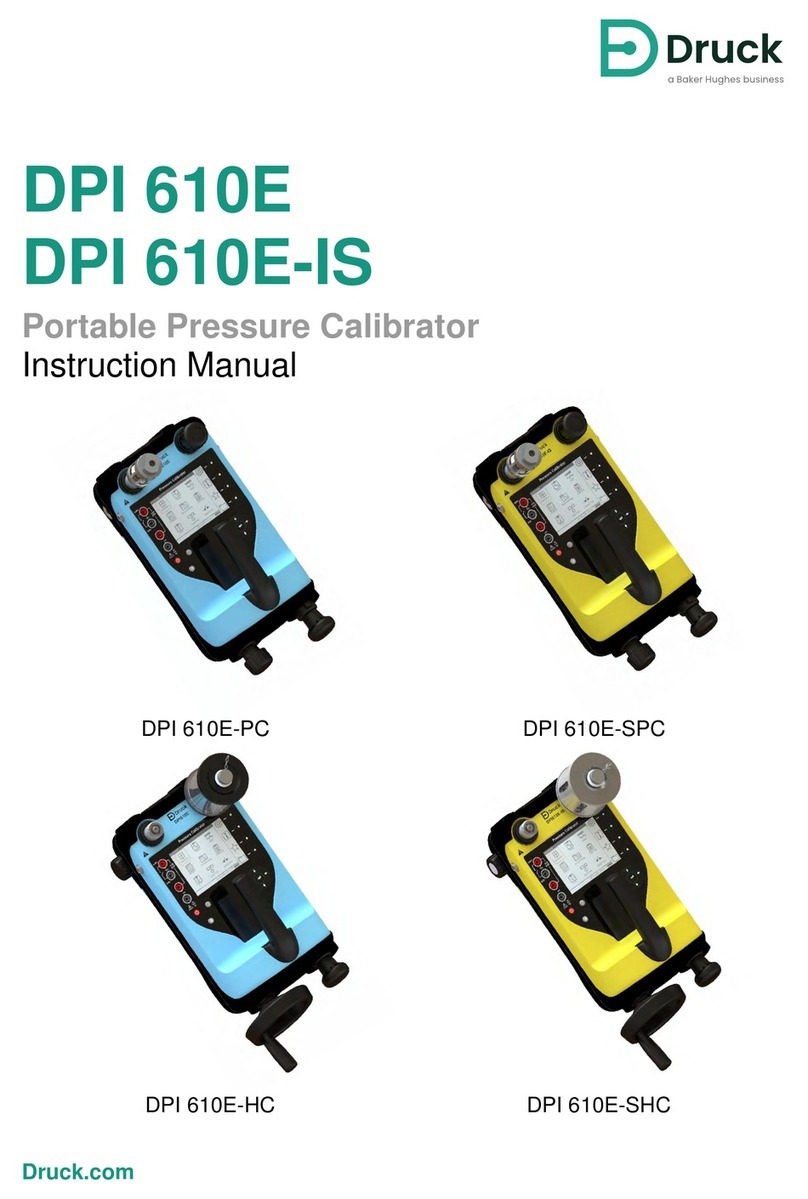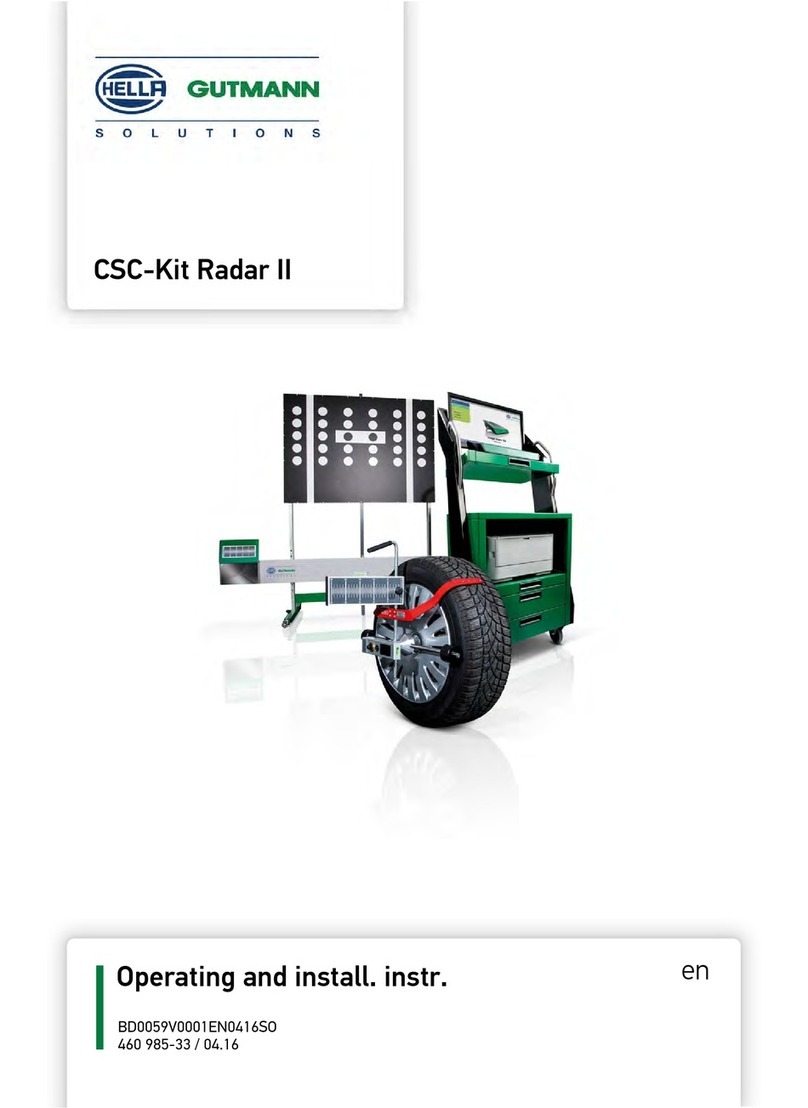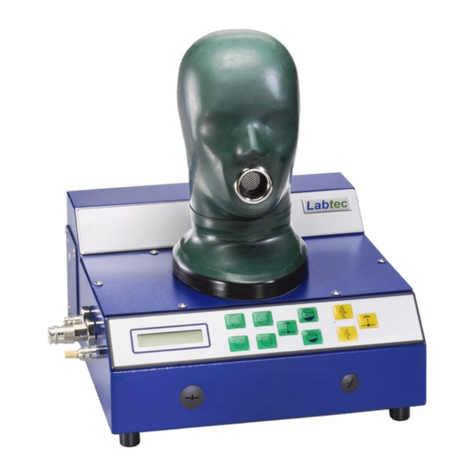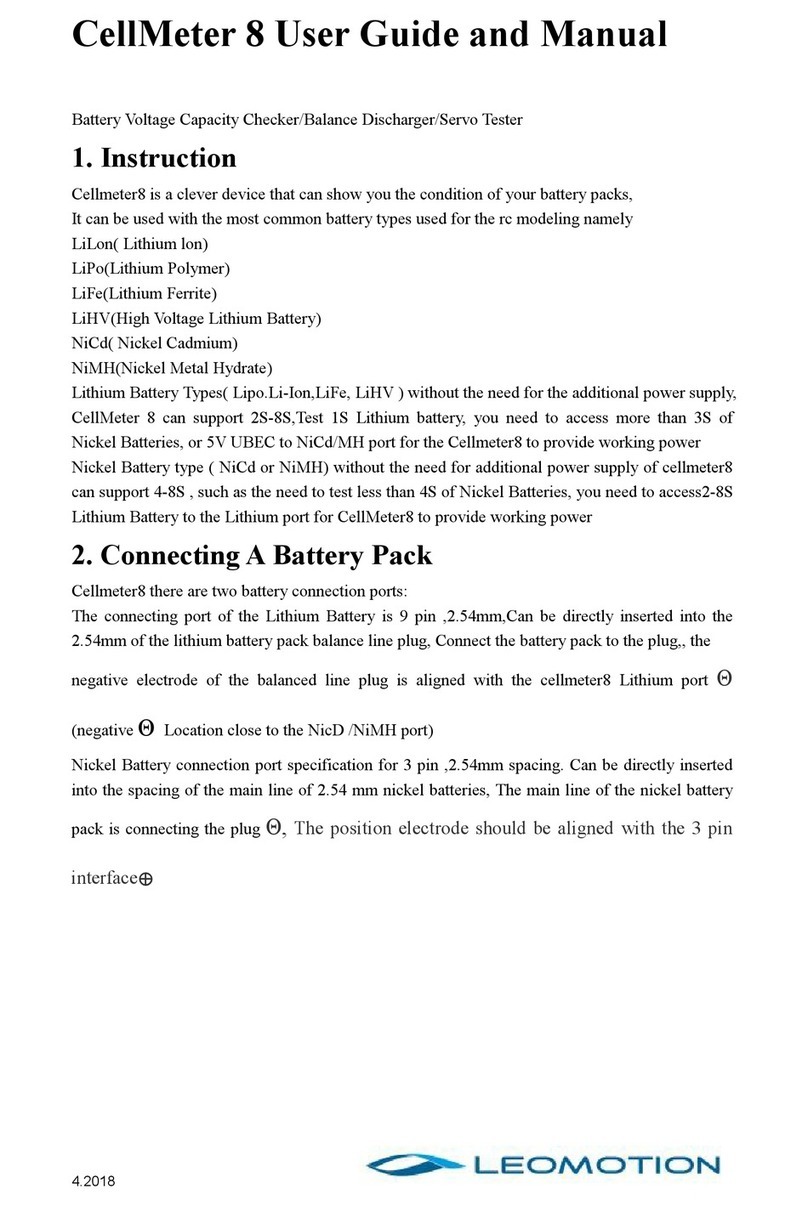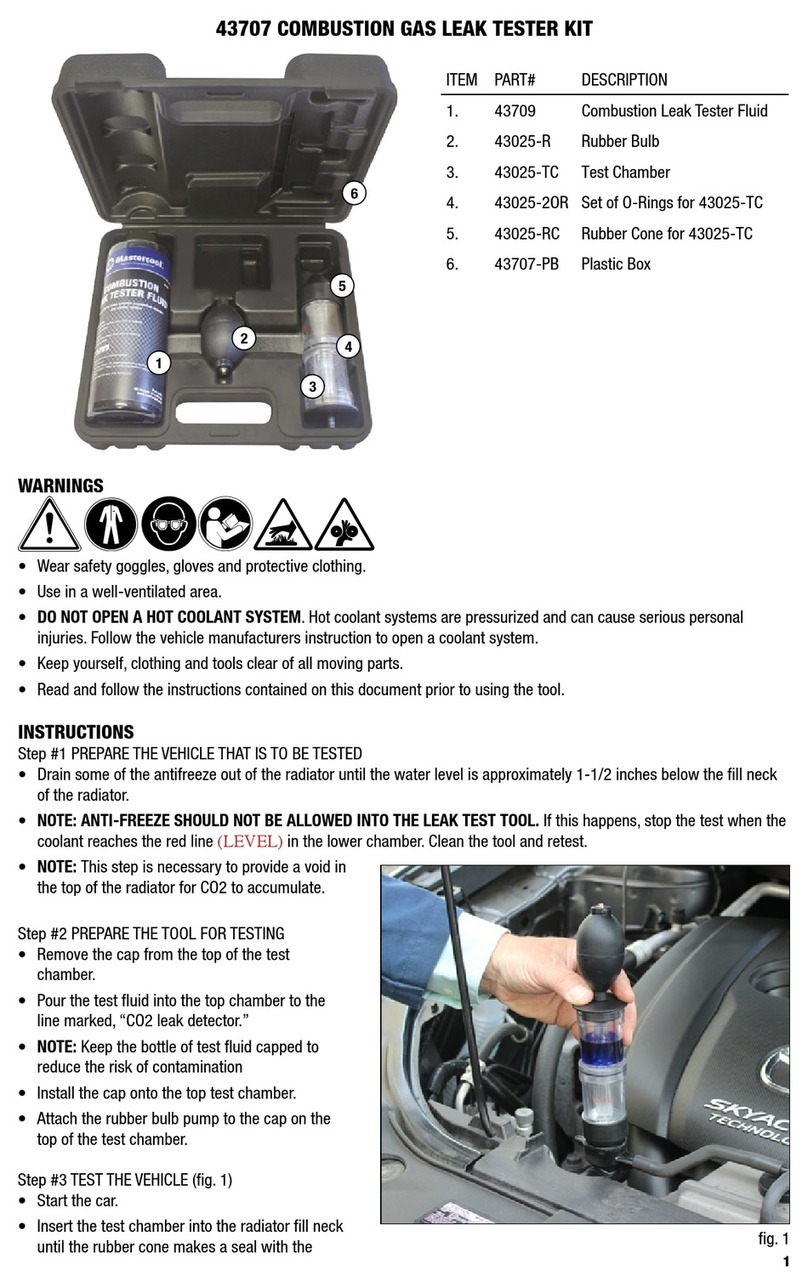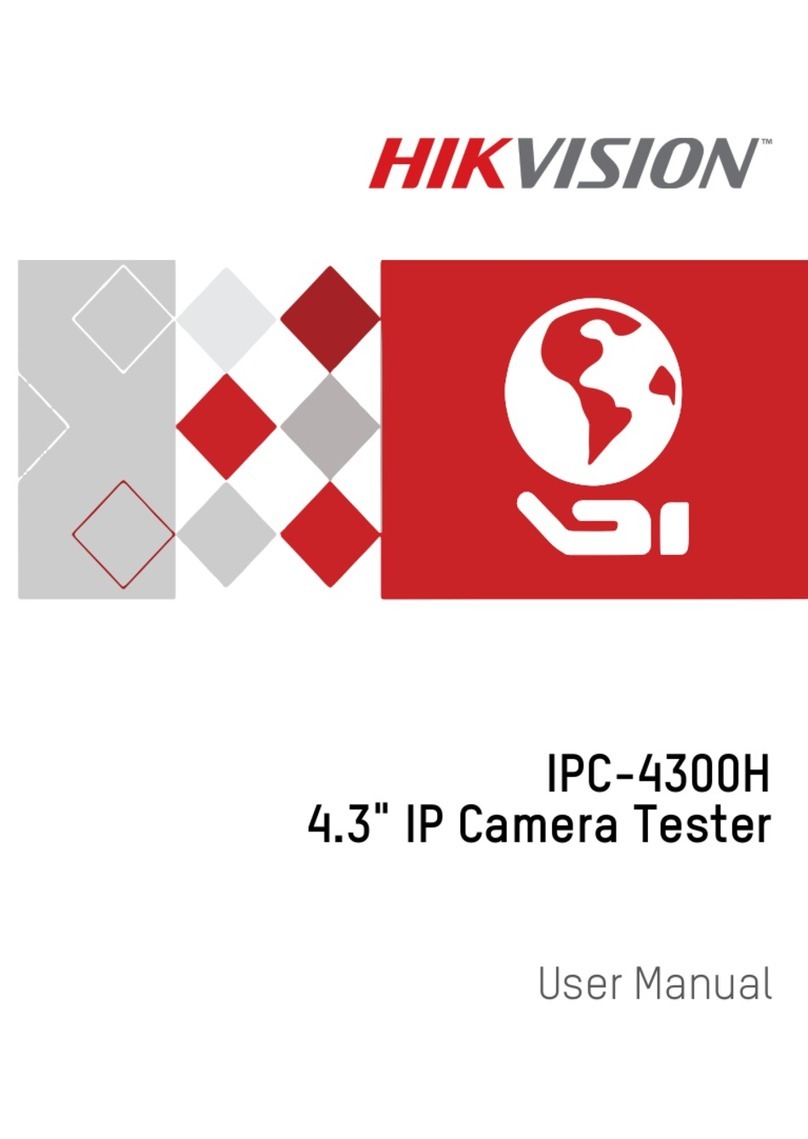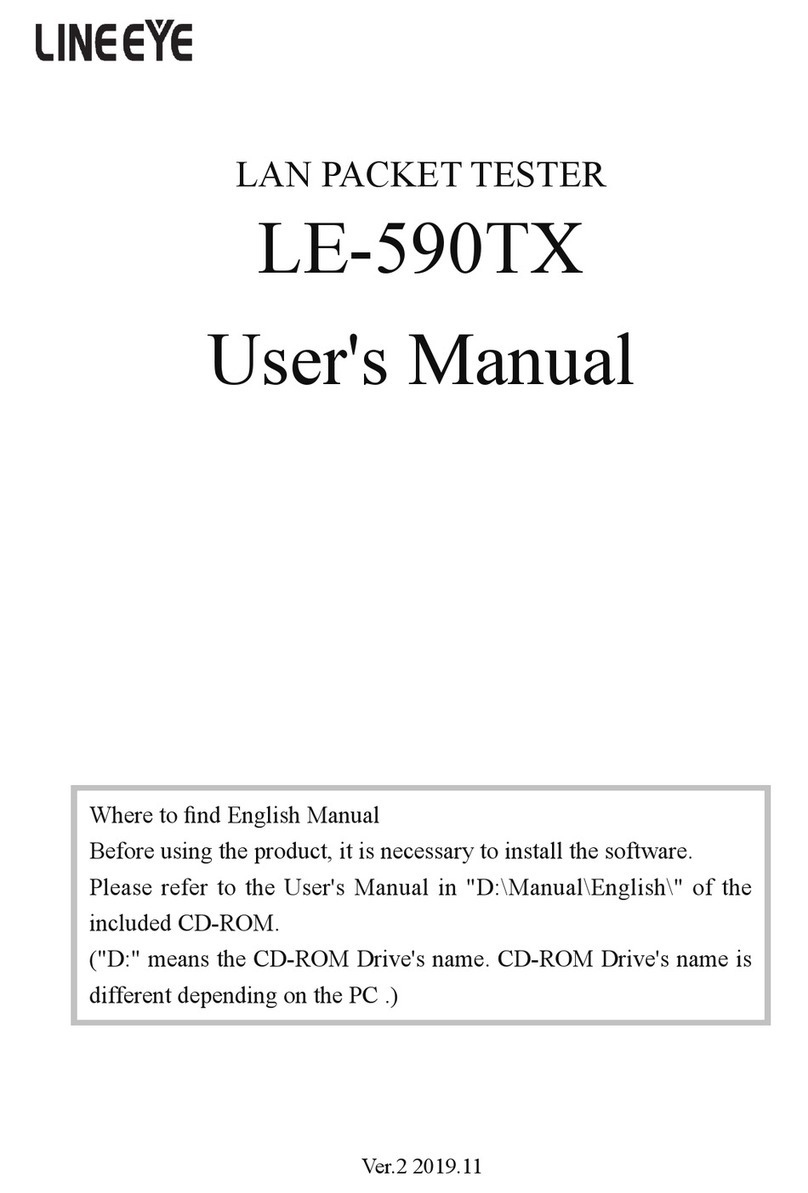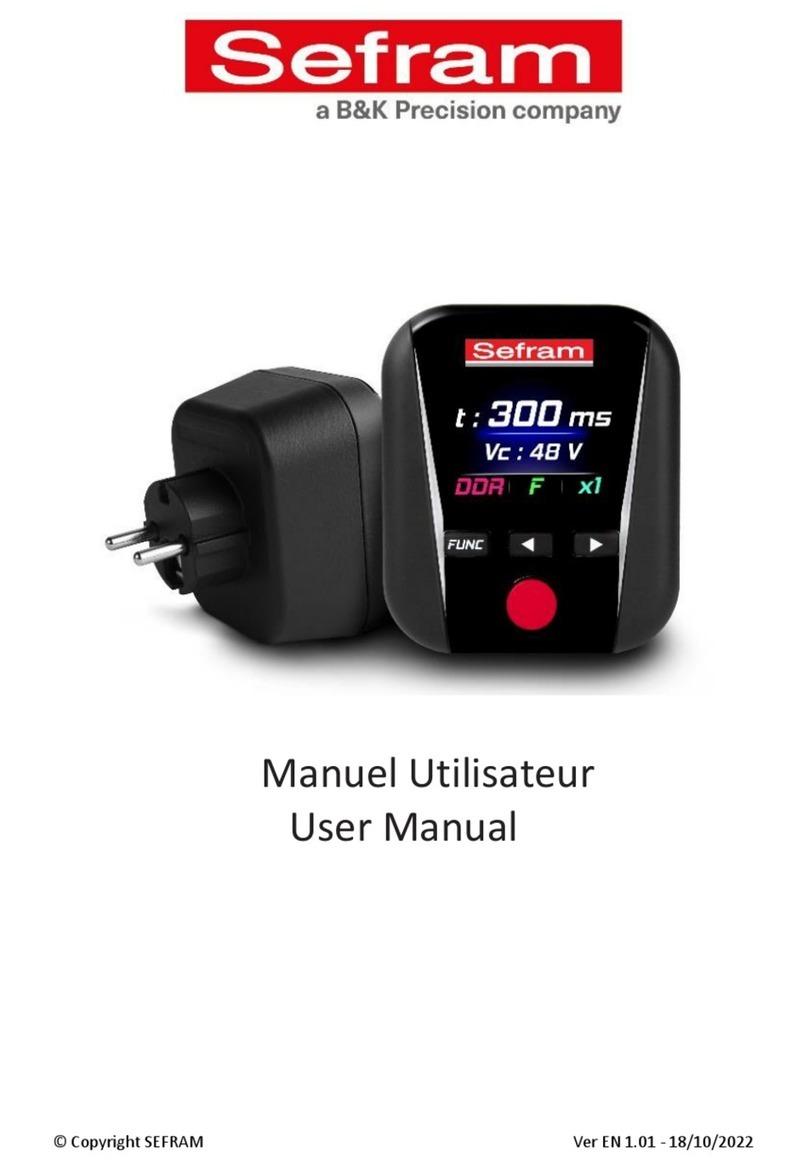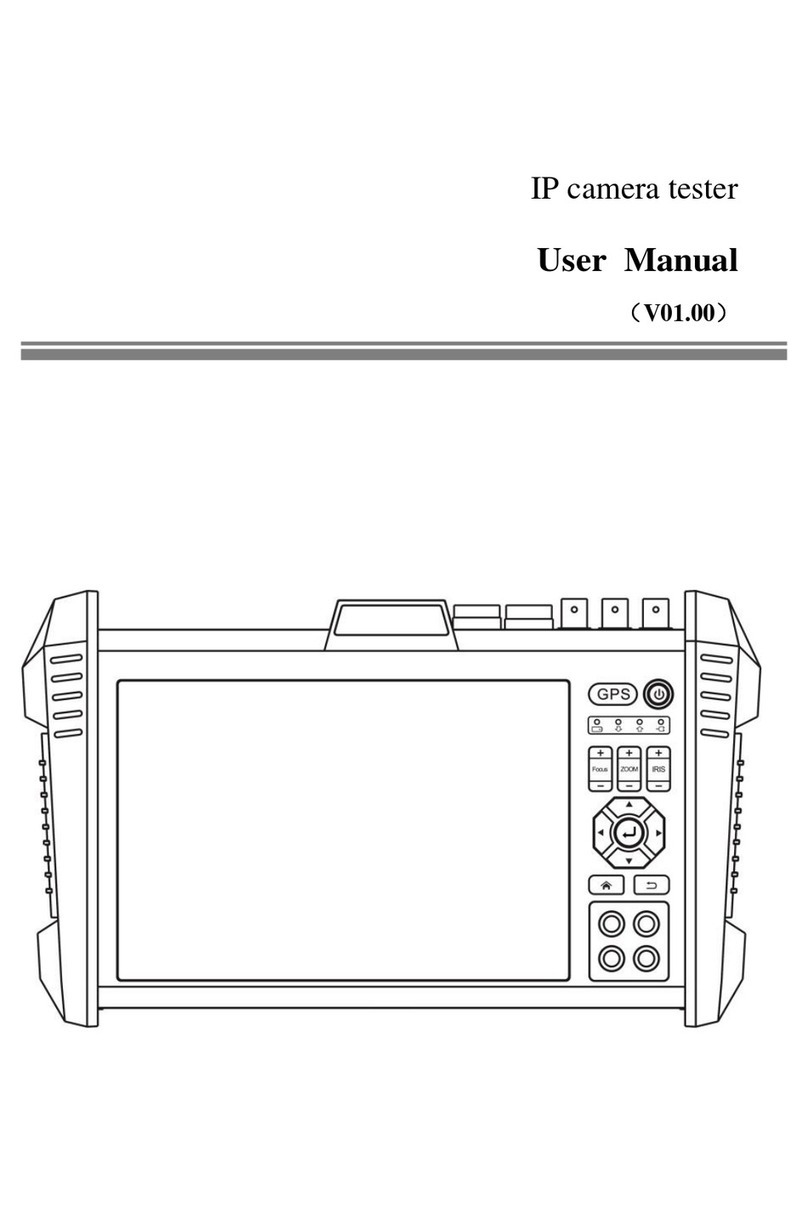Crypto Hagelin CX-52 Operating and installation instructions

<*-
SQSSPm
CRYPTO AG.
ZU6
(Switzerland - Suisse)
Description of
CRYPTOGRAPHERS "HAGELIN" TYPE CX-52
Table of Contents
I, Introduction
A. Foreword
B. General remarks
C. Definitions
II. General description
A. Principal units
B. Illustrations
C. Detailed explanations
No 3027
2
3
4
7
14
17
I I I . C h a r a c t e r i s t i c s a n d c r y p t o g r a p h i c a l p o s s i b i l i t i e s 3 3
Post address Cable
Z Z 1 Z * , Z u g , W e i n b e r g s t r a 3 s e 1 0 % £ - ( 0 4 2 ) 4 3 6 3 2 T ^ g r _ C R Y P T O Z U G

l!>:WI>!BJ:hM4
N o 3 0 2 7 - 2 -
I. INTRODUCTION
A^ ^reword
To the users of the Kagelin type C Cryptographers, manufactured
since 1936, such as the C-36, ..., C-48,.,... , C-446, and the con
verter M-2Q9, the exterior and the mechanism of the new CX-52
machines will seem familiar, even if the indicating disk has been
replaced by a stationary alphabet ring and a movable index, placed
on the cover for the type wheel assembly. As in the C-machine there
is an indicating knob at the left side of the machine, connected
to two typewheels, which is set by hand for each operation.
This knob is mechanically connected to the movable index, by
which the letter to be ciphered or deciphered is indicated. 3y
pulling a lever at the right side of the machine, the ciphering
or deciphering of each letter is eff e c t e d , a s a s l i d e b a r d r u m ,
co ntrolle d by s ix keywhe els, is the n re volved fo r one compl et e
turn, during which the alphabetwheel unit is displaced a number
of steps. The primary letter is printed immediately before the
displacement begins, the secondary letter is printed after its
comp l e t ion, and t h e t a pe, on wh i c h t he lett e r s a re prin t e d , is
then advanced to receive the following imprints.
Th e descr iptio n aims to g ive a clear e xplan ation o f the
functions and the cryptographical properties of the machines. It
has been found pertinent to make some references to, and comparisons
with the earlier tj?pes. When making such references, type C-446
will be cited; a description of this machine will on request be
supplied to those who are not familiar with it.
Some expressions in the description may sound unfamiliar or
even incorrect to the reader. No internationally approved vocabulary,
pertaining to ciphering machines has however been established, and
the correct usage of some cryptological terms is still disputed.
The purpose of the appended list of definitions is therefore only
to help the reader to understand the meaning of certaiD special
expressions in the following description.

3 0 2 7 - 3
B. General remarks
The new machines are the result of the experience gathered
during more than 25 years of manufacture of ciphering machines. The
application of new principles offers the users new and valuable
possibilities. Due to the completely new design, operation and
servicing will be simplified.
The new machines have the following characteristics in common
with the machine C-446:
1. Small overall dimensions: 198 x 138 x 105 mm
(ab. 7 3/4 x 5 3/8 x 4 VS")
including protective cover.
and low weight : 3 kgs (ab. 6,6 lbs.)
2. The same machine is used for both ciphering and deciphering.
3. The clear(plain) text and the enciphered text are rendered in
printed form on separate tapes. The two tapes are however in
this machine cut from one single strip by a rotary cutter,
which is incorporated in the paper feed mechanism. The new
paper roll has the same width as the standard telegraph per
forated tape, 17.3 mm (ll/l6"), and is placed conveniently
accessible in the baseplate. When enciphering, both texts are
automatically divided into groups of five letters, and the
letter in the clear text, which indicates the space between
words (such as the x, w or other, depending on the language
u s e d ) , i s a l s o p r i n t e d ; w h e n d e c i p h e r i n g t h e c i p h e r t e x t i s
printed in a continuous sequence, while the clear text is
rendered with the proper spacing between words. This arrange
ment has been chosen not only because it simplifies the con
struction of the printing unit and brings the convenience of
a single paper roll, but also because the comparison and
control of the texts will in this way be made easy: the
corresponding letters of the two texts will always be found
exactly one above the other, when the tapes are laid along
side each other.
4. The operating speed is satisfactory, as from 30 to 60 letters
per minute can be rendered, depending on the skill of the
operator.

9
3027
C. Definitions
Arbitrary_alphabets-
When arbitrary alphabets arc used, the sequence of the letters
of both the primary and the secondary alphabet is chosen at random
The use of arbitrary alphabets demands two alpkabetwheel units, one
for the ciphering and the other for the deciphering operation.
Inverse alphabets.
These can have the nornal (alphabetic, sequence of the letters,
or any desired sequence, only the sequence of the letters of the
secondary alphabet must run in opposite direction to the sequence
of the primary alphabet. IVith inverse alphabets the same alphabet-
wheel is used both for enciphering and for deciphering.
Enciphering_and deciphering.
These operations are, seen as machine functions, identical.
When such operations of the machine are described, they will al
w a y s b e c a l l e d c i p h e r i n g , i n o r d e r t o a v o i d t h e r e p e t i t i o n o f t h e
expression "enciphering or deciphering1', unless deciphering is spe
cifically described.
Keys
The machine contains a number of variables, which have to be
set according to instructions, prepared by those responsible for
the cipher service in question. Each setting of a variable
cor r espo n ds to a sp e cifi c k ey for t h e elem e nt in qu e sti o n. Set t ing
all the variable elements (according to instructions) corresponds
to the "keying" of the machine.
The purpose for the specific keys is.
- on one hand to have the machine produce a cipher of a high
quality,
- on the other,to permit the correspondence between two or more
u s e r s . A c o r r e s p o n d e n c e w i l l e v i d e n t l y b e p o s s i b l e o n l y i f a l l
the variable elements are set identically,
- and finally to set those elements, whose positions will change
during operation of the machines (the keywheel units and the
typewheel assembly), in their identical starting positions.

MuwiiiBjlim-i
r.
e
302'
We shall call the firstnamed settings: basic keys, and the keys for
the starting positions: initial keys.
Basic keys.
These comprise the following elements
a) The bar drum:
1; - types of bars used
2) - the arrangement of the lugs on the bars
3, - in certain cases, the sequence, in which the bars are
placed.
b) The key wheels:
1/ - the choice of keywheels to be used
2) - the sequence, in which they are placed in the machine
3 ; - t h e a r r a n g e m e n t o f t h e p i n s i n t h e p i n d i s k s
c) The typewheel assembly:
In case rearrangeable letters and types are used, their sequence
or when using interchangeable alphabet rings, their choice.
Initial keys:
These comprise the following elements:
d) The position of the keywheels, defined by the index letters on
th eir c rowns , rel ative t o the ind ex li no on the m ach ine cov er.
e) The relative position between the two typewheels of the alpha
bet-wheel unit, defined by the place of a chosen index letter
on the indicating disk.
Displacement and advancement.
The ciphering operation consists in causing the alphabet unit
to change its position, after having set it to indicate the primary
letter. As the alphabetwheel normally carries 26 letters on each
ring, it can take 26 different positions. The change in position,
which is caused by the slidebar drum which revolves one turn for
each operation, and which acts as a gear sector which meshes with
the alphabetwheel gearing, is called displacement.
The nu mb er o f st ep s (e ac h st ep i s l/ 26 th o f a re vo lu ti on ) is
called displacement steps. The series of displacement steps which
follow one after another, for the ciphering of a message, is called
d i s p l a c e m e n t s e r i e s , o r s u b s t i t u t i o n s e r i e s . A s t h e d i s p l a c e m e n t
series is defined lay the arrangement of the keywheel and their
movement, it can in some contexts also be called key series.

3 0 2 7 - 6 -
The keywheels are subjected to a similar displacement as the
alphabetwheel unit, although we may use the advancement in such
cases when we want to distinguish between the movement of the alpha
betwheel unit and the keywheels.
The word displacement is also used in connection with the
slidebars as a better expression has unfortunately not been found.
The slidebars, which are contained in slots in disks, of which the
drum is made up, can take two positions, by being slid from a right
end position to a left end position, for a distance of about
2 ^2 cms (0,1"). We call the right end position the undisplaced and
the left end position the displaced position.
Indication
When a message is to be ciphered, the moveable index is brought
to register with the letters in the text - they are indicated - after
which the operating lever is pulled and the ciphering operation is
effected.
Primary and secondary
These terms are used to denote that when a message is to be
enciphered or deciphered, the text in hand is the primary text, and
it is printed by the primary typewheel; the result of the operation
is the secondary text,., printed by the secondary typewheel. Thus,
when enciphering, the original clear text is the primary text, and
the resulting cipher is the secondary text; when deciphering, the
cipher is the primary text, and the reconstituted clear text is the
secondary text. The primary text consists of primary letters, the
secondary of secondary letters.

run
A lrMU:n4:H3i'SW
30s
II. GENERAL DESCRIPTION
A. Principal units
The machines type CX-52 are assembled from the following six
main units:
1 - Baseplate
2 - Left bearing Plate
3 - Slidebar Drum
4 - Right bearing Plate
5 - Keywhcel Units
6 - Alphabetwheel Unit
In order to facilitate the identification of the different
parts, the first digit in the number given to a part, will be that
of the main unit:
Parts, belonging to the Baseplate 1
the Left Bearing Plate .... 2
the Slidebar Drum . . 3
the Right 3earing Plate ..... 4
the Key-wheel Units ... 5
the Alphabetwheel Unit 6
The units are listed in the sequence they are assembled into
a complete machine, with the Baseplate as starting point and
foundation.
We refer to the list of illustrations which is treated in "B".
Not all parts enumerated there, may be visible on these illustration
they will be shown in a separate complete parts list, L 013.

mwiiiikitt
3027 _ 8 -
f
»
List of mentioned parts.
Numbers in | j brackets are group numbers and not shown while their
component parts are given on the pictures
[1]
11
12
13
101
102
103
104
111
112
121
122
123
124
131
1111
14
15
16
17
[18]
151
181
182
183
184
185
1821
Baseplate
Under side:
paper roll guard
tape transfer slot
keywheel grooves
tension regulator
bottom cover plate
bottom cover plate pin
notch
rubber feet
lock
lock arm for outer cover (15)
lock arm for machine cover (47)
main key (with two notches)
ope r ato r 's ke y ( wit h c ne not ch;
paper roll
paper tape
Upper side:
release latch for bottom cover
plate (ll)
outer cover
locking hook for (121)
keywheel retaining bar
recoil spring
retractor unit
retractor bar
right arm
cam follower
left arm
journal bracket
flat spring.
shown on the
pictures:
3
3
4
j
1
none
none
1
3
1,2
2,4
2
none
3
3,5
4,5
1,2
2
5
none
8,9,11
a
o
8 to 11
none
8
none

suou
3HOII
£x
£l
£x
v
3U0TI
onou
f
3UOU
croo pooj aod-Bc!
croo 3uT.aux.id Aj-opuooes
ctbo A-d:
rreo 2uT.aux.id jCj-onTJtd
tsoxsueaxe 3Aj.jp
: ^pjti ntjo
t7 jeA3-[ 'J-aqoanj
fr 3Tpt;a:o Jtexioj notpuj
fr 3*sxp 3utacj.no
* xa\\ox uoxaoxaj
1/ ejxt! SutJfijeq JtaxxoJC ^T^0!111
*jooqjft. aeqoaujt
f SfStp Sutaano
fr J9TXOJ P39I
Vx qoujf poej jo dud
euou 3\XV J3XI0J P33J
:ootAop paej X&CLV&
pj-cr.3 jedtjd
J3A9X 3uT.aiit.zd AMupuooes jo 3ux.tds
J3A3X Sutautxd Axvuzxd jo Sux-ids
J9A8X xo.xauoo 3utdnoa3
•I3A3T Sutotids
JOA3X JO pU3 XVOX
jonnxjq SutautJtd
JceAax Sutautad Aj-cpuooes
.lOAex jo pue xvox
■learxoq Sutautjd
jeAox 3uxauxad Aannxad
qouT[ ct-o
B\XV
atun yutautj:^
iziz
iiz
s£s
x£z
[iz]
I9SS
l£SS
i
ZilZ
xixz
8SS
£SS
9SS
£SS
TBS
6ts
8IS
ITS
9TS
SIS
!>is]
ss]
STS
ITS
[IS]
seanaotd epts ajeq
f> siTid onitivss Mai
6
fWrTrlMI
LS0£

3027
lI/JfJliKBiiMiii
S3?
- 10
[24J 5-letter grouper
241 letter grouper axle
242 counter drive
243 ratchet wheel
244 control disk
25 F-V device
251 control knob
252 control shaft
[253j lever unit
2531 slide lever
25311 lever extension
2532 fixed lever
254 spring
255 retractor fork
256 axle
26 side cover
2601 alphabet-wheel cover
26011 release knob
knob "0" [for (273)J
counter
reset knob
p r i m a r y i n k r o l l e r
secondary ink roller
primary locking pawl
secondary locking pawl
2741 knob "R" [for (274)]
right side:
28 slidebar reset disk
29 journal plate
291 slidebar drum stop lever
292 intermediate gear wheel
261
271
272
273
274
2602
2611
pictures
none
4
4
4
1,13
13
13,14
13
13
13,14
4,13,14
13,14
2
2
2
1
1
1
2,4
2
2
1
none
4
none
5

3027
fMHJ«.W.to
- 11 -
31
32
321
322
323
3231
33
34
35
36
L3?j
38
39
41
42
43
45
46
351
361
371 & 376
372 to 375
381 to 387
388
411
47
461
462
463
473
474
475
48
Slidebar drum
drum shaft
left end disk
stop control cam
notch
slidebar retaining ring
slot
right end disk
retractor bar cam (for (181))
guidearm locking bar cam
notch
driving gear
ratchet notch
bar supporting disks
supporting disks
supporting disks
slidebar
slidebars driving teeth
notched right ends of bars
movable .lug'
Right bearing plate
operating lever
retractable handle
gear segment
spring
locking lever
guide arm locking bar
left arm
right arm
bar extension
inner cover
disk slots
index line
locking pin
opening for handle (411)
pictures .
4,12
8,9
5
none
none
5
5
5
8 to 11
8,10
8
8
none
none
5
12
none
2,5,12
5
1,5
1,5
none
2,5
8,10
2,8,
10 to 12
8
8
8
2
5
1
2
5

miwwBimi.vi
- 12 -
3027 pictures:
5 Keywheel unit 2,4,5,12
51 pin disk 5,7,8
5 1 1 d i s k p i n s 5
5111 active pin 7,8,9
5112 inactive pin 7,8,9
512 disk positioning slot 7
53 driving and locking gear 5,7
531 positioning pin 7
54 guidearm assembly 5,10
541 feeler arm 7,9
5411 feeler extension 7,8,9,11
5412 rear extension 7,8
542 guide arm 7,9 to 12
5421 guide surface 7,8,12
544 spring 7,8,11
55 locking pawl 5,7,12
56 intermediate gear 7,12
56l stud none
57 bearing plate 5,7
571 hollow bearing 7
572 spring-pin 7
573 notch 5,7
58 spring 7,8,9
59 positioning shaft 4,5
[6] Alphabet wheel unit
Note: there are: a) fixed alphabets
b) rearrangeable alphabets
only b) is shown
61 operating knob 1,5
62 gear wheel 5,13
63 primary thypewheel 2,5,13
63I type ring 5
64 secondary typewheel 2,5,13
641 spacing pin 5

68
Kimnmmm-i
3 0 2 7 - 1 3 -
66
picture?
driving end locking gearwheel 2,5,13
hollow bearing 5
671 positioning notch
spring
Subassembly, mounted in cover (26OI)
none
none
indicating disk 1
6901 indicating ring 5
69011 rearrangeable letters 5
691 movable index 1
6911 red index 1
692 gear wheel 2

HLimil.BW. 37nr
3027 _ 14
B. Illustrations
Picture 1 is a general view of the machine, with outer cover 15
opened.
There can be seen on the left side:
- t h e c o n t r o l k n o b
the reset knob (26ll)
the paper feed knob (222)
the operating knob (6l)
the indicating disk (69)
the knobs "0" and "R"
Throughthe six slots (473) in the inner cover (47), across which the
white indexline (474) is drawn, the six pin disks (5l) are seen.
At the extreme right the operating lever (41) is visible.
Picture 2 is similar to picture l), only the covers (2601) and (47)
are opened, and we can now also see:
the type wheels (63) and (64)
- the gear wheel (66)
the key wheels (5)
the bar (46)
part of the drum with a number of bars (38), carrying
lugs (39)
the gear wheel (692)
the knob (26011)
the ink roller (271) and (272)
the locking pawls (273) and (274)
the main key (123)
the spring (43)
the lock arms (l2l) and (122)
Picture 3 is a bottom view, with the bottom cover (ll) removed.
It shows:
the tension regulator (104)
the paper roll (13)
the guard for same (101)
the tape transfer slot (102)

3 0 2 7 - 1 ' 5 -
- the tension regulator (104)
the lock (1-2)
-
Picture 4" shows the machine with the following parts removed:
The covers (26) (15) (2601) (47) the alphabetwheel unit (6), the
keywheel units (5).
This allows us to see, to the left of the plate (2),
the printing unit (21) with paper guard (219)
- the paper feed device (22)
t h e l e t t e r g r o u p e r ( 2 4 )
the F-V device (25)
Further to the right we see
the keywheel unit grooves (103), and
- the sixth keywheel unit (5)
The shaft (59) has been partially pulled out.
Pic t ure 5 sh o ws th e m achi n e from t h e fro n t, wit h a ll cov e rs
opened, and with the following parts removed: the five keywheel
units (5) I to IV and VI, and the alphabetwheel unit (6).
In the machine we see:
the paper tape (131) as it leaves the feed mechanism
- the keywheel unit (5) V
the drum with end disks (32,33)
the supporting disks (372 to 375)
- the retaining ring (323)
the slidebars (38) with lugs (39)
the operating lever (41) with retractable handle (411)
- the keywheel positioning shaft (59), partly withdrawn.
In the right side plate (4), the hole (48) is seen, in which the
handle (41l) lodges, when the machine is closed up. One of the
bars (38) is shown partly removed.
The slot in the retaining ring (323), through which the left end
of the bar has passed, is also visible.
In front of the machine, we see:
a) - alphabetwheel unit (6) with operating knob (6l)
- the indicating disk (69)

nW))!BJ.hM4
*
3027 _ 16
- the primary and secondary typewheel (63, 64)
- tha drirlng gear wheel (66)
b) Three keywheel units (5) with keywheel plate (57)
- the locking pawl (55)
- the guide arm (54)
- the driving gear (53)
the pin disk (51)
- t h e p i n s ( 5 11 )
The notch (573) in the bearing plate engages the bar (l6) when the
keywheel units are in place.
Picture 6 shows the slidebars (38) which are normally supplied for
the machine type CX-52, shown in nondisplaced positions. The seven
rows of double lines make it easy to recognize the different types
of teeth used on the slidebars. The left of each set of double
lines shows the path of the intermediate gear (56), and the right
set the path of the locking pawl (55) in relation to the teeth
(381 to (387) of the slidebars (38).
The CX-bars mu3t have 7 sets of teeth.
Picture 7 shows the keywheel unit (5) in detail.
Picture 8-11 show the basic operation of the guidearm unit cycle
(see page 27 - 29)
Picture 12 gives a summary of the action of the slidebars with the
different driving teeth types (see page 29 - 30)
Picture 13 and 14 show the two basic settings of the F-V device viz;
the position F in picture 13 and the position V in picture 14
(see page 2l).

3 0 2 7 - 1 7 -
C. Detailed explanation.
1 - T h e b a s e p l a t e ( P i c t u r e 1 t o 5 )
The baseplate (l) has the shape of an inverted rectangular box. The
hollow space is used to house the paper roll (13), which becomes
accessible when the bottom cover plate (ll) is removed. The cover
plate is locked in place with the latch (14), which engages with
a notch (lill) in the bottom plate pin (ill), and can be released
only when the outer protecting cover (15) of the machine is opened.
Four rubber feet (112) in the plate (ll) assure a firm stand for
the machine, when in use. The slot (102) permits the transfer of
the paper tap e from the roll to the printer com partment of the
machine.
A special lock (12) with two lock arms (121, 122; serves to lock the
outer cover (15) and the inner cover (47). "?hen the operator's
key (124) is used, this will unlock only the outer cover (15; which
will allow to use the machine.
With the main key (123) both covers will be unlocked, and the
ciphering mech anism will also become accessible for the setting
or rearrangement of the keying elements.
On the upper surface of the baseplate (l) there are six shallow..
grooves, (103; with a bar (l6) riveted across them, which serves
for the pos i t i o n i n g o f the keywh e e l u n i t s ( 5 ). Th e b a s e plate is
further drilled and tapped for screws, with which the following
parts are fastened:
- t h e o u t e r c o v e r ( 1 5 )
- the bearing plates (2) and (4)
the latch (14)
- the recoil spring (17)
- the retractor unit (18)
The retractor unit (18) is used for the control of the keywheel-
guidearm-units. It consists of the retractor bsr (181) which is
cradled in the journal bracket (184)• The cam follower (1821) of the
flat spring (185) presses the cam follower (1821; of the right arm .
(182) against the cam (34) of the slidebar drum unit (3)»

r
3 0 2 7 - 1 8 -
Left Bearing Plate (Pictures 2,4,5)
This part is heavily channelled, and contains several mechanism:
a) - the printing unit (21) with paper guard (219)
the paper feed device (22)
- t h e c a m u n i t ( 2 3 ;
- t h e 5 - l e t t e r g r o u p e r ( 2 4 )
the F-V device (25;
The side cover (26) encloses these parts.
Inside the side cover (26) the three-digit counter (26l) is mounted;
it can be read through an aperture in the cover. The counter checks
automatically with the counter drive (242) when the cover (26) is
put in place; the knob (26ll) serves to reset the counter (26l)
to zero.
b) on the right face are mounted:
the slidebar reset disk (28)
- the journal plate (29), with the bearing for the shaft (59)
on the journal plate (29) are mounted:
- the slidebar drum stop lever (29l)
the intermediate gear wheel (292,
the locking pawl (274)
A cover (2601) is hinged between the side cover (26) and the journal
plate (29); it protects the alphabetwheel unit (6) and holds the
indicating disk (69)-
21 - The printing mechanism (picture 4)
I t c o n s i s t s ( f r o m l o f t t o r i g h t ) o f :
the C-D knob (212)
th e printin g le vers (213 & 2 14) with th e sp acing lev er (215)
and the grouping control lever (216), which are mounted on
the axle (211).
The forward upper ends of the printing levers carry rubber tipped
hammer heads (2131, 2141); the rear ends (2132, 2142) of these
levers press against the cams (232,233/ of the cam unit (23), which
is mounted on the left end of the drum shaft (3l)-

iimmmi
3 0 2 7 - 1 9 -
The two coil springs (217,218) provide the striking force for the
printing hammers.
The cam (232) is notched to allow the printing hammer (2131) to
str ike a g ain s t the p rima ry ty p ewh eel (6 3) at th e beg i nni n g of th e
operating cycle.
The cam (233) is notched so that the hammer (2141) will strike at
the end of the cycle against the secondary typewheel (64).
The paper tape (131) is inserted from the under side of the baseplate
(l) through the tension regulator (104), the transfer slot (102),
the paper guard (219), and between the feed roller (223) and the
f r i c t i o n r o l l e r ( 2 2 6 ) .
22 - The paper feed roller (Picture 4)
The roller (223) is mounted on the axle (221). At the left end of
the roller is a knob (222) by which it can be turned by hand; at its
right end is a ratchet wheel (224).
The friction roller (226) is mounted in the cradle (227), which is
pivoted on the axle (225) and presses against the roller (223) by
tension from the springs (217,218), whose upper ends are fastened
to the cradle.
The feed roller and the friction roller are fitted with cutting
disks (2231, 226l), which cut the tape into two strips when the
tape is advanced between the two rollers.
2 3 - T h e c a m u n i t
The cam (232) has an additional curve (2321) on its left side, for
the operation of the F-V device (25).
To the right of the cam (233) there is a cam (234) for the operation
of the paper feed ra tchet lever (228), which en gages the ratche t
wheel (224), and causes the feed roller (223) to turn one step for
each operation.
When enciphering however, the 5-letter grouper (24) will permit the
ratchet lever (228) to make a longer feed movement for each fifth
operation, so that there will be an extra space between each
5-letter group.

3 0 2 7 - 2 0 -
The notched drive extension (23l) of the cam unit (23) serves as
a coupling when the machine is mounted on the B-52 device, for
electric drive.
It will be seen that all movements, for the printing and for the
advancement of the paper tape are controlled by the cam unit (23).
These movements have been timed in such a way that the primary
l e t t e r w i l l b e p r i n t e d o n t h e l e f t p a r t o f t h e t a p e , b e f o r e t h e
displacement of the alphabet wheel unit begins, and the secondary
letter will be printed on the right part of the tape after this
operation. The tape is advanced (and cut at the same time) immedi
ately before the primary letter is printed.
24 - The 5-letter grouper
This device is mounted on the axle (241) and carries a control
disk (244), (with two diametrically placed notches) and a ten-teeth
ratchet wheel (243).
At the extreme right of the cam unit (23) is an excentric cam
(234) on which the ratch t drive lever (228) is placed: this ad
van ces t he co ntr ol di sk (2 44) o ne te nth o f a rev olu tio n for ea ch
operation. The control notches will allow a double-space feed for
every fifth operation, if the C-D knob is in C-position (i.e. (En
ciphering). When the C-D switch is in D-position (Deciphering), the
control disk will become inoperative.
The coupling between the 5-letter grouper (24) and the counter (26l)
can only take place in one position, which has been chosen so that
the 5-letter space will coincide with a 0 or 5 on the unit digit of
the counter (i.e. 110, 235, etc.)
It should be mentioned here that the C-D knob has also another
function:
1. - When in D-position, it will place the spacing lever (215)
where it will contact the spacing pin (641) of the secon
dary typewheel (64), and prevent the printing of the letter
which has been designated to represent the space between
w o r d s , w h e n t h i s i s i n t h e p r i n t i n g p o s i t i o n .
2. - In C-position, the spacing lever (2l5)will be inoperative.
Table of contents
Popular Test Equipment manuals by other brands
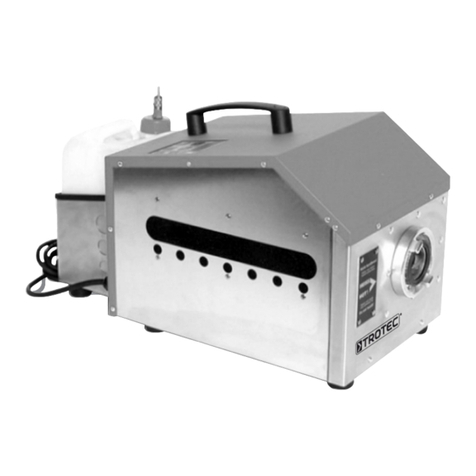
PROMAT
PROMAT TROTEC FS 100 operating instructions
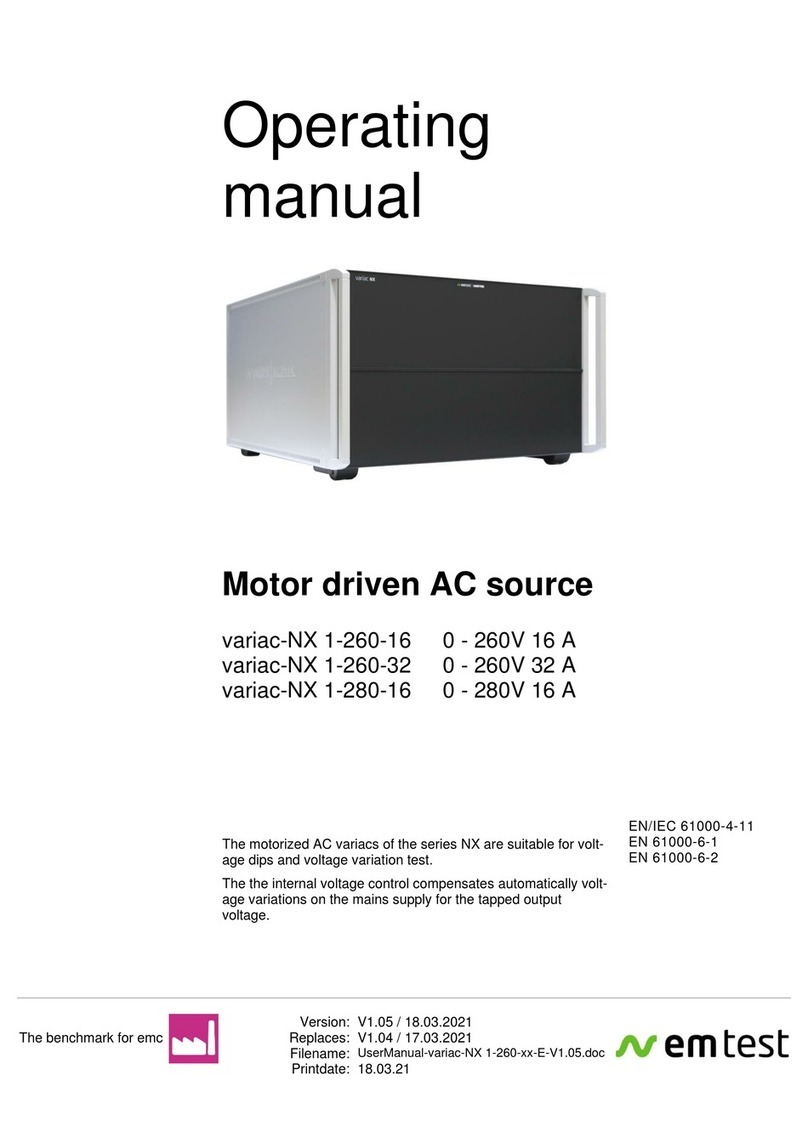
EMTEST
EMTEST variac-NX 1-260-16 operating manual
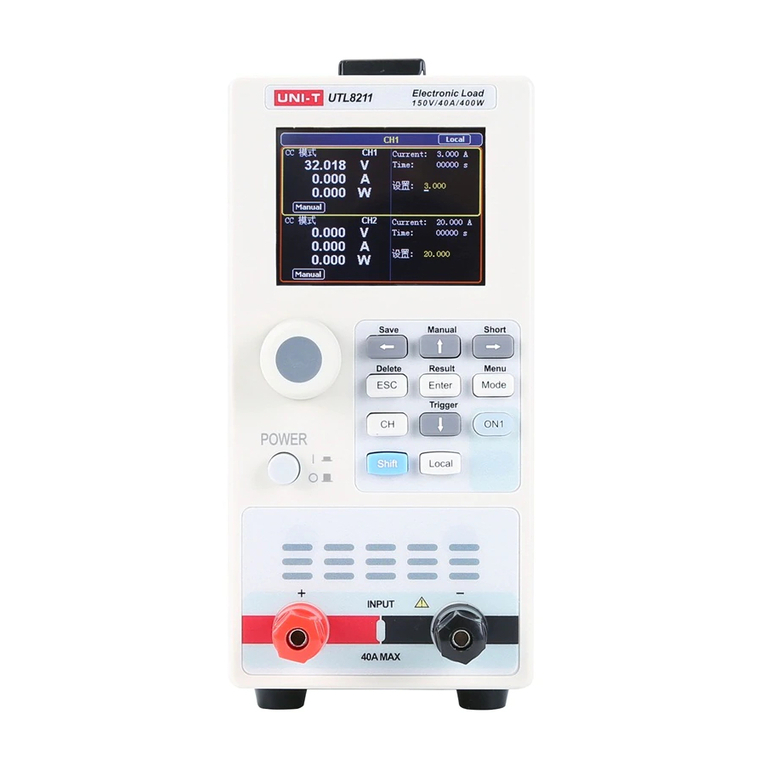
Unit
Unit UTL8200 Series user manual
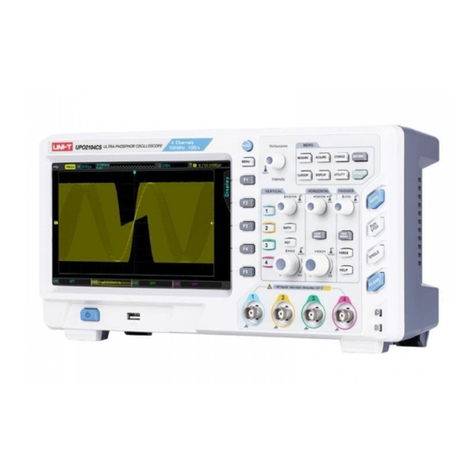
Unit
Unit UPO2000CS Series user manual
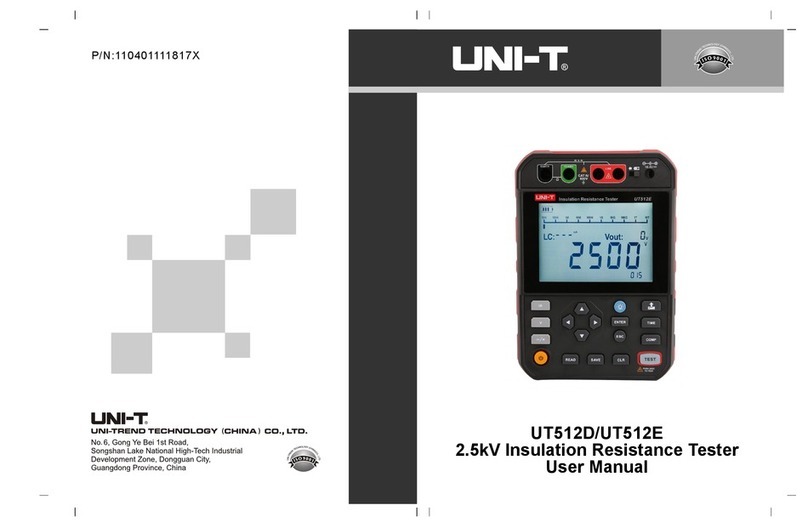
Unit
Unit UT512D user manual
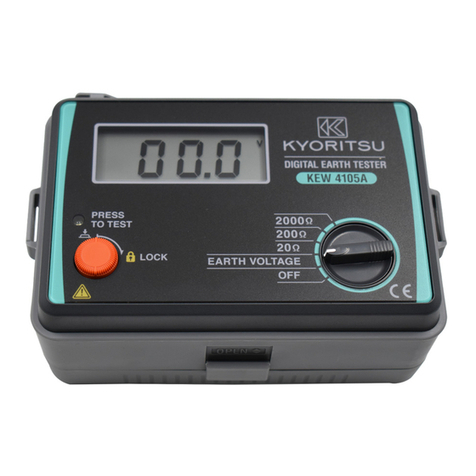
Kyoritsu Electrical Instruments Works, Ltd.
Kyoritsu Electrical Instruments Works, Ltd. KEW 4105A instruction manual
